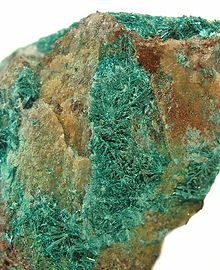Botallackite, chemical formula Cu2(OH)3Cl is a secondary copper mineral, named for its type locality at the Botallack Mine, St Just in Penwith, Cornwall. It is polymorphous with atacamite, paratacamite and clinoatacamite.[2]
| Botallackite | |
|---|---|
 Botallackite from the Levant Mine, Cornwall | |
| General | |
| Category | Halide minerals |
| Formula (repeating unit) | Cu2(OH)3Cl |
| IMA symbol | Blk[1] |
| Strunz classification | 3.DA.10b |
| Crystal system | Monoclinic |
| Crystal class | Prismatic (2/m) (same H-M symbol) |
| Space group | P21/m |
| Unit cell | a = 5.717 Å, b = 6.126 Å, c = 5.636 Å; β = 93.07°; Z = 2 |
| Identification | |
| Colour | Shades of green |
| Crystal habit | Platy interlaced crystal crusts |
| Cleavage | {100} Perfect |
| Mohs scale hardness | Soft |
| Diaphaneity | Transparent to translucent |
| Specific gravity | 3.6 |
| Optical properties | Biaxial (+) |
| Refractive index | nα= 1.775, nβ= 1.800, nγ= 1.846 |
| Birefringence | δ = 0.071 |
| Pleochroism | Weak – blue green shades |
| Dispersion | r > v, strong |
| References | [2][3][4] |
Botallackite crystallises in the monoclinic crystal system. It is mountain-green to green in colour, with one distinct to good cleavage.[2]
Discovery and occurrence edit
It was first described in 1865 for an occurrence in the Botallack mine, Cornwall, England, and named for the type locality.[2]
Botallackite forms in copper deposits exposed to weathering and salt water.[2] It is reported from black smoker deposits due to reaction of primary sulfide minerals with seawater. It also occurs on copper bearing slag exposed to seawater. Minerals associated with botallackite include atacamite, paratacamite, brochantite, connellite and gypsum.[3]
References edit
- ^ Warr, L.N. (2021). "IMA–CNMNC approved mineral symbols". Mineralogical Magazine. 85 (3): 291–320. Bibcode:2021MinM...85..291W. doi:10.1180/mgm.2021.43. S2CID 235729616.
- ^ a b c d e Mindat information page for Botallackite
- ^ a b Handbook of Mineralogy
- ^ Webmineral data